Benjamin Franklin (Frank) Wallack: 17th Kansas, Co. D
Rank: Private
Place of enlistment:
Mustered into Federal service:
Service time: 100 Days
Born:
Age at enlistment: 20 years old
Height: 5’9”, dark hair, blue eyes
Civilian occupation: Farmer
Family Lineage:
Benjamin Franklin, son of “Kansas” Benjamin, son of John Jr., son of John Sr., son of “Bedford County” Michael, son of Esther and Hans Michael Wallick.
During the American Civil War it was not uncommon for soldiers to have different spellings of their surnames written in their service records. The surname Wallick can be found on military documents with alternate endings of "a-c-k" and "e-c-k" (it is clear that most of the time the changes were due to clerical errors). Two of the three Wallick soldiers buried in our national cemeteries have alternate spellings of Wallick on their headstones. Both Isaiah Wallick, buried at
Hiram Ulysses Grant (his real name) was nominated to
There is one Wallick soldier who spelled his name Wall-a-c-k and it was not a clerk's error or careless penmanship but a deliberate change made by that soldier. All of Benjamin Franklin Wallack’s service records are consistent in spelling his last name, Wall-a-c-k, from his signature on the enlistment papers through his compiled service record. Benjamin Franklin Wallack was called “Frank” by his family and friends, and so he will be called in this biography to avoid confusing Frank with his father, “
Benjamin Franklin "Frank" Wallack, 1870
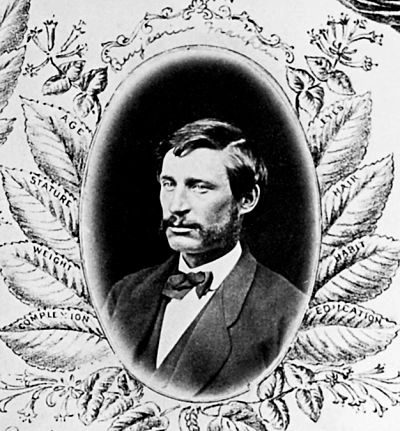 One family account states that Benjamin Franklin Wall-i-c-k deliberately changed his name to Wall-a-c-k early in his young adult life. The story is told that Frank's wife, Ellen Green, had pressed the matter of changing the spelling of his surname and that Frank finally agreed. This well-educated eastern woman felt that the spelling of Wallick had somehow become cor-rupted through the years. Her rationale was that back east, every Wallick she knew ended their name in A-C-K. Two brothers, John and Charles, had business ties with Frank and they also agreed to change their names. This irritated and ang-ered their father, Benjamin, who threatened to disinherit them all. In order for this story to be true, Frank and Ellen Green would have to have met and agreed to this name-change issue before he enlisted, because all of Frank's service records from the National Archives are all spelled Wall-a-c-k. However, the marriage did not actually take place until seven years after his enlistment, making the truthfulness of this story suspect. In any case the name change happened and there is a branch of the Hans Michael Walck/Wallick family that spells its name Wall-a-c-k and that can be traced back to Benjamin Franklin Wallack (1844-1887).
One family account states that Benjamin Franklin Wall-i-c-k deliberately changed his name to Wall-a-c-k early in his young adult life. The story is told that Frank's wife, Ellen Green, had pressed the matter of changing the spelling of his surname and that Frank finally agreed. This well-educated eastern woman felt that the spelling of Wallick had somehow become cor-rupted through the years. Her rationale was that back east, every Wallick she knew ended their name in A-C-K. Two brothers, John and Charles, had business ties with Frank and they also agreed to change their names. This irritated and ang-ered their father, Benjamin, who threatened to disinherit them all. In order for this story to be true, Frank and Ellen Green would have to have met and agreed to this name-change issue before he enlisted, because all of Frank's service records from the National Archives are all spelled Wall-a-c-k. However, the marriage did not actually take place until seven years after his enlistment, making the truthfulness of this story suspect. In any case the name change happened and there is a branch of the Hans Michael Walck/Wallick family that spells its name Wall-a-c-k and that can be traced back to Benjamin Franklin Wallack (1844-1887).
Frank Wallack’s very early childhood days were spent in
The Kansas/Missouri border war was an ugly affair; a bloody insurrection that preceded our national civil war by nearly a decade. Small groups of anti-slavery partisans called Jayhawkers, and pro-slavery zealots called Bushwhackers, waged war against each other. These were roaming mobs of partisans rather than an organized militia. Stephen Douglas, the senator from
"Kansas" Benjamin Wallack, 1870
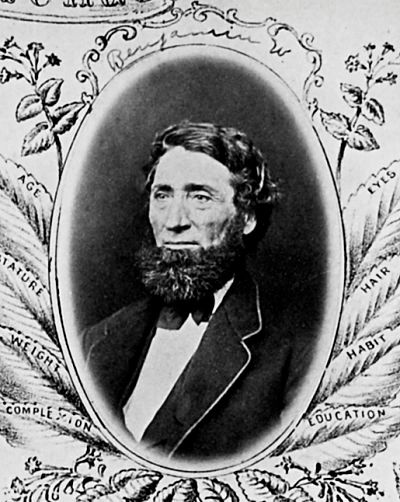 Why would Frank’s father, Benjamin, willingly move his family into a region where violent civil insurrection was taking place? He had no encouragement from his wife, Mary. When she first saw the miles upon miles of bleak, treeless prairie land she became desperate to return to her home back in
Why would Frank’s father, Benjamin, willingly move his family into a region where violent civil insurrection was taking place? He had no encouragement from his wife, Mary. When she first saw the miles upon miles of bleak, treeless prairie land she became desperate to return to her home back in
Mid-1800s photo of a homestead in Atchison County, Kansas.

This is how Atchison, Kansas looked in 1860 when Benjamin Wallick arrived in town.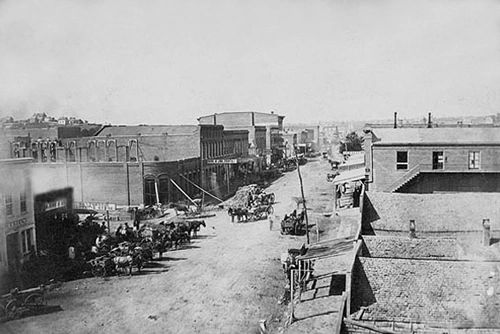
Frank Wallack's descendants have told the story that he was a substitute soldier for his father, but apparently that is not so. There is nothing in Frank's compiled service record from the to support such a claim. Frank has regular enlistment papers for the 17th Kansas Volunteer Infantry and he was mustered into Federal service for 100 days in the summer of 1864.
Frank Wallack's enlistment paper dated July 18, 1864. If he had been a substitute soldier, a different document would have been used. (See Huette Wallick, substitute soldier document)

1864
JUL 28 Frank Wallack is mustered into Federal service with the 17th Kansas Infantry Regiment at
AUG-SEP Frank Wallack and his company are sent to
William Clarke Quantrill- Dover, Ohio
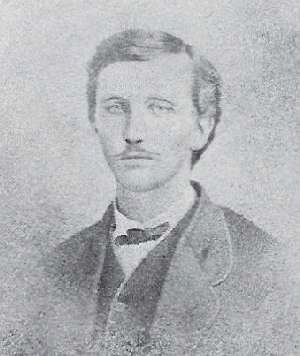 Historical Note- If Frank Wallack did go to
Historical Note- If Frank Wallack did go to
The raid on Lawrence, Kansas in the summer of 1863 was perhaps the most savage attack perpetrated on a civilian population during the entire Civil War. Company D of the 17th Kansas Infantry was posted in Lawrence a year after the massacre. Frank Wallack would have seen first-hand the devastation leveled on that community.
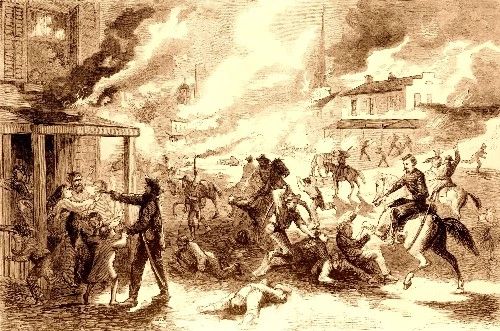
OCT-NOV The regiment helps repel General Price’s invasion into
NOV 16 The 17th Kansas Infantry is mustered-out of Federal service at
Frank Wallack returned to
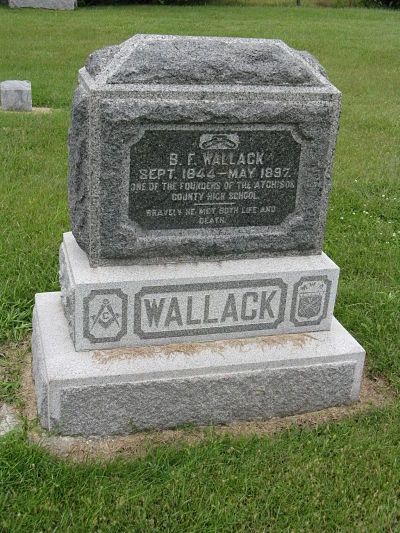
Inscription:
B.F. Wallack
Sept. 1844-May 1897
One of the Founders of the Atchison
County High School
Bravely He Met Both Life And Death
Tributes to Senator Benjamin Franklin Wallack were read into the official record of the Kansas State Senate on December 23, 1898. To read a full transcript of the proceedings, click on the link below and begin reading on page 98.
http://books.google.com/books?id=g7ZKAAAAMAAJ&pg=PA103&lpg=PA103&dq=wallack+atchison+county+high+school&source=bl&ots=RB7ruH07lK&sig=iD4Py8ArpcgIAnolTh-r0b4HtIU&hl=en&ei=q1Y6TcHmJIudgQew2-jECA&sa=X&oi=book_result&ct=result&resnum=3&sqi=2&ved=0CCUQ6AEwAg#v=onepage&q=wallack%20atchison%20county%20high%20school&f=false
Much of "Kansas" Benjamin's family history was taken from the transcript, “My Wallick Family” by Vesta Beatrice (Wallick) Kaufman and Adalaide (Covell) Wallick. The original transcript resides in the Latter Day Saints Library in Salt Lake City, Utah.
Comrades-in-Arms
No brothers or first cousins
Song: Johnny's Gone for a Soldier
Return to top
Return to Wallick Family Website
